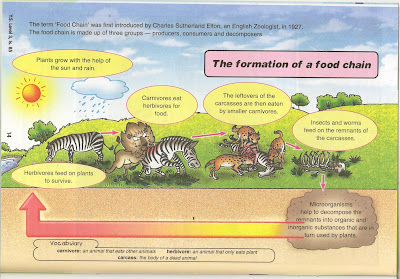The Young Scientists Level 1 Issue 99
Friday, January 20, 2012
Robin's Adventure at Sea - Part 1 and 2
Fruits Juicy Fruits
The Young Scientists Level 2 Issue 97
Thursday, January 19, 2012
The Malayan Tapir
Have you ever seen a Malayan tapir? This animal is easily identified by its markings, especially the light-coloured patch which extends from its shoulders to its rear. This pattern is for camouflage. Other animals may mistake it for a large rock rather than a prey when it is lying down to sleep.
Malayan tapirs grow to between 1.8 to 2.4m in length, stand 90 to 107cm tall and weigh between 250 to 320kg. Some can weigh up to 500kg. The females are usually larger than the males. Like the other types of tapirs, they have small stubby tails and long, flexible proboscises. They have four toes on each front foot and three toes on each back foot.
The Malayan tapir has very poor eyesight but excellent hearing and sense of smell. It is most active at night. It is the largest of the four tapir species at birth and grows more quickly than the others. The female tapir produces one calf every two years. The Malayan tapir can live up to 30 years, both in the wild and in captivity.
Test Your Science
1. How long is the gestation period of the Malayan tapir?
Get to know another nocturnal animal, the owl in the Young Scientists Issue 113 Level 1.
Three States of Matter
Are you familiar with the three states of matter, solid, liquid and gas? Let's see what is in a solid. A solid is made up of particles known as molecules packed closely together. The forces between the molecules are so strong that the molecules cannot move freely but only vibrate. As a result, a solid has a stable, definite shape and a definite volume. A solid can only change its shape by force, that is ,when it is broken or cut. Solids can be transformed into liquids by melting and liquids can be transformed into solids by freezing. Solids can also change directly into gases through the process of sublimation.
A liquid is a nearly incompressible fluid that takes the shape of its container but keeps an almost constant volume independent of pressure. When a solid is heated above its melting point, it becomes liquid.
A gas is a compressible fluid. Not only will a gas fit in with the shape of its container but it will also expand to fill the container. A gas has no definite shape or volume, but occupies the entire container in which it is kept. A liquid may be converted to a gas by heating at constant pressure to the boiling point or by reducing the pressure at constant temperature.
Test Your Science
1. At which state(s) does matter have no definite shape?
Read about the three states of a candle in the Young Scientists Issue 113 Level 2.
Charcoal
Do you know that there are different types of charcoal? Below are some of them.

 Extruded Charcoal Briquets
Extruded Charcoal Briquets
Bamboo Charcoal
Today lump charcoal is made mostly from the scraps from the lumber making process. Bark, limbs, odd chunks, twigs and ends from the mill are carbonised by smoldering them in a kiln (a steel or stone building with very little oxygen allowed in). The result is irregular chunks that leave little ash since there are no binders as in briquets.
The big disadvantage is that lump charcoal is harder to find, more expensive than briquets, burns out more quickly, varies in heat output per bag, varies in wood type and properties from bag to bag and often contain a lot of useless carbon dust from improper filtering in the factory and rough handling in the stores.
Discover the uses of charcoal in the Young Scientists Issue 113 Level 3.

 Extruded Charcoal Briquets
Extruded Charcoal BriquetsBamboo Charcoal
Today lump charcoal is made mostly from the scraps from the lumber making process. Bark, limbs, odd chunks, twigs and ends from the mill are carbonised by smoldering them in a kiln (a steel or stone building with very little oxygen allowed in). The result is irregular chunks that leave little ash since there are no binders as in briquets.
The big disadvantage is that lump charcoal is harder to find, more expensive than briquets, burns out more quickly, varies in heat output per bag, varies in wood type and properties from bag to bag and often contain a lot of useless carbon dust from improper filtering in the factory and rough handling in the stores.
Test Your Science
1. What is the advantage of using lump charcoal in cooking compared to briquets?
Discover the uses of charcoal in the Young Scientists Issue 113 Level 3.
What is Compost?
Do you know anything about compost? Is compost useful? How do you make a compost?
The Young Scientists Level 3 Issue 80
Wednesday, January 18, 2012
Do you know how a food chain is formed?
Subscribe to:
Comments (Atom)































